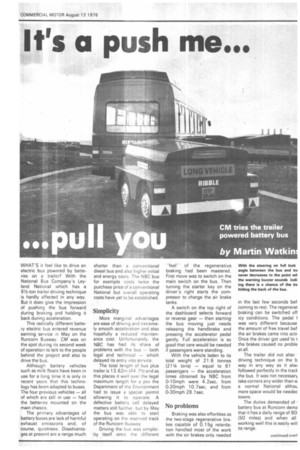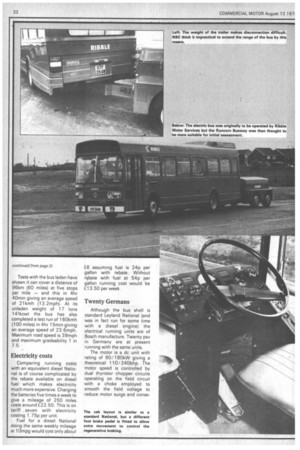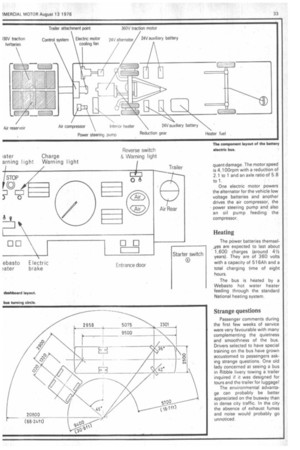It's a push me...
Page 33

Page 34

Page 35

If you've noticed an error in this article please click here to report it so we can fix it.
CM tries the trailer powered battery bus
by Martin Watkin
WHAT'S it feel like to drive an electric bus powered by batteries on a trailer? With the National Bus Company's Leyland National which has a 91/2-ton trailer driving technique is hardly affected in any way. But it does give the impression of pushing the bus forward during braking and holding it back during acceleration.
This radically different battery electric bus entered revenue earning service in May on the Runcorn Busway. CM was on the spot during its second week of operation to talk to the people behind the project and also to drive the bus.
Although battery vehicles such as milk floats have been in use for a long time it is only in recent years that this technology has been adapted to buses. The four previous vehicles — all of which are still in use — had the batteries mounted on the main chassis.
The primary advantages of battery buses are lack of harmful exhaust emissions and, of course, quietness. Disadvantages at present are a range much shorter than a conventional diesel bus and also higher initial and energy costs. The NBC bus for example costs twice the purchase price of a conventional National but overall operating costs have yet to be established.
Simplicity
More marginal advantages are ease of driving and extremely smooth acceleration and also hopefully a reduced maintenance cost. Unfortunately, the NBC has had its share of problems with the bus -both legal and technical — which delayed its entry into service.
The total length of bus plus trailer is 13.62m (44.7ft) and as this places it well over the legal maximum length for a psv the Department of the Environment had to issue a special permit allowing it to operate. A defective battery cell delayed matters still further, but by May the bus was able to start operating on the reserved track of the Runcorn Busway.
Driving the bus was simplicity itself once the different "feel" of the regenerative braking had been mastered. First move was to switch on the main switch on the bus. Then turning the starter key on the driver's right starts the compressor to charge the air brake tanks.
A switch on the top right of the dashboard selects forward or reverse gear — then starting. the bus moving just needs releasing the handbrake and pressing the accelerator pedal gently. Full acceleration is so good that care would be needed if passengers were standing.
With the vehicle laden to its total weight of 21.6 tonnes (211/4 tons) — equal to 61 passengers — the acceleration times obtained by NBC from 0-10mph were 4.2sec, from 0-20mph 10.7sec, and from 0-30mph 28.1sec.
No problems
Braking was also effortless as the two-stage regenerative brakes capable of 0.15g retardation handled most of the work with the air brakes only needed
With the steering on full lock angle between the bus and tra never decreases to the point wh the warning buzzer sounds indi, ing there is a chance of the trz hitting the back of the bus,
in the last few seconds bet' coming to rest. The regenerat braking can be switched off icy conditions. The pedal f was very different because the amount of free travel bef the air brakes came into actii Once the driver got used to t the brakes caused no proble at all.
The trailer did not alter • driving technique on the b way in any way as it alwi followed perfectly in the tra6 the bus. It was not necessary take corners any wider than w a normal National althou more space would be needed towns.
The duties demanded of 1 battery bus at Runcorn dema that It has a daily range of 801 (50 miles) and when all working well this is easily witl its range.
Tests with the bus laden have shown it can cover a distance of 96km (60 miles) at five stops per mile — and this in 4hr 40min giving an average speed of 21kmh (13.2mph). At its unladen weight of 17 tons 143Acwt the bus has also completed a test run of 160kmh (100 miles) in 4hr 15min giving an average speed of 23.6mph. Maximum road speed is 39 mph and maximum gradeability 1 in 7.5.
Electricity costs
Comparing running costs with an equivalent diesel National is of course complicated by the rebate available on diesel fuel which makes electricity much more expensive. Charging the batteries five times a week to give a mileage of 250 miles costs around £22.50. This is on tariff seven with electricity costing 1.75p per unit.
Fuel for a diesel National doing the same weekly mileage at lOmpg would cost only about £6 assuming fuel is 24p per gallon with rebate. Without rebate with fuel at 54p per gallon running cost would be £13.50 per week.
Twenty Germans
Although the bus shell is standard Leyland National (and was in fact run for some time with a diesel engine) the electrical running units are of Bosch manufacture. Twenty psv in Germany are at present running with the same units.
The motor is a dc unit with rating of 90 / 180kW giving a theoretical 110 / 240bhp. The motor speed is controlled by dual thyristor chopper circuits operating on the field circuit with a choke employed to smooth the field voltage to reduce motor surge and conse quent damage. The motor speed is 4,1 0Orpm with a reduction of 2.1 to 1 and an axle ratio of 5.8 to 1.
One electric motor powers the alternator for the vehicle low voltage batteries and another drives the air compressor, the power steering pump and also an oil pump feeding the compressor.
Heating
The power batteries themsel_yes are expected to last about 1,600 charges (around 41/2 years). They are of 360 volts with a capacity of 51 6Ah and a total charging time of eight hours.
The bus is heated by a Webasto hot water heater feeding through the standard National heating system.
Strange questions
Passenger comments during the first few weeks of service were very favourable with many complementing the quietness and smoothness of the bus. Drivers selected to have special training on the bus have grown accustomed to passengers asking strange questions. One old lady concerned at seeing a bus in Ribble livery towing a trailer inquired if it was designed for tours and the trailer for luggage!
The environmental advantage can probably be better appreciated on the busway than in dense city traffic. In the city the absence of exhaust fumes and noise would probably go unnoticed.




























































































